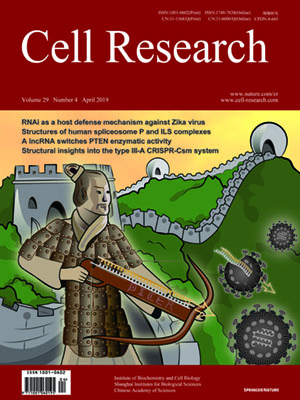
Advanced Search
Submit Manuscript
Advanced Search
Submit Manuscript
Volume 29, No 4, Apr 2019
ISSN: 1001-0602
EISSN: 1748-7838 2018
impact factor 17.848*
(Clarivate Analytics, 2019)
Volume 29 Issue 4, April 2019: 265-273
Yan-Peng Xu 1, Yang Qiu 2, Boya Zhang 3,4, Guilai Chen 3,4, Qi Chen 1, Miao Wang 2, Fan Mo 3,4, Jiuyue Xu 2,4, Jin Wu 5, Rong-Rong Zhang 1,6, Meng-Li Cheng 1,6, Na-Na Zhang 1, Bao Lyu 2,7, Wen-Liang Zhu 3,4, Meng-Hua Wu 3,4, Qing Ye 1, Da Zhang 3,4, Jiang-Hong Man 5, Xiao-Feng Li 1, Jie Cui 2,4, Zhiheng Xu 4,8, Baoyang Hu 3,4, Xi Zhou 2,4,7 and Cheng-Feng Qin 1,6
1 State Key Laboratory of Pathogen and Biosecurity, Beijing Institute of Microbiology and Epidemiology, Academy of Military Medical Sciences, 100071 Beijing, China; 2State Key Laboratory of Virology, Wuhan Institute of Virology, Chinese Academy of Sciences (CAS), Wuhan 430071 Hubei, China; 3State Key Laboratory of Stem Cell and Reproductive Biology, Institute of Zoology, CAS, 100101 Beijing, China; 4University of Chinese Academy of Sciences, 100049 Beijing, China; 5State Key Laboratory of Proteomics, Institute of Basic Medical Sciences, National Center of Biomedical Analysis, 100850 Beijing, China; 6School of Basic Sciences, Anhui Medical University, Hefei 230032 Anhui, China; 7College of Life Sciences, Wuhan University, Wuhan 430072 Hubei, China and 8State Key Laboratory of Molecular Developmental Biology, Center for Excellence in Brain Science and Intelligence Technology, Institute of Genetics and Developmental Biology, CAS, 100101 Beijing, China
https://doi.org/10.1038/s41422-019-0152-9